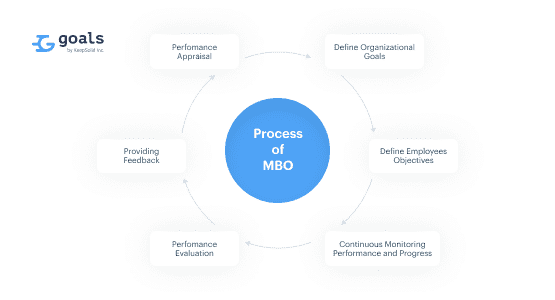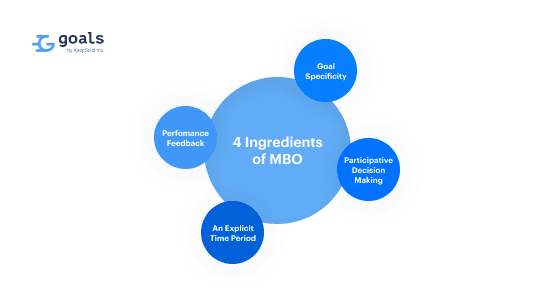What is Management by Objectives (MBO)
Management by Objectives (MBO) is a management model intended to improve an organization’s strategic planning process and performance. It does that by clearly defining Objectives (followed by respective Key Results and Tasks) that are agreed upon by both employees and management. Together, these elements will form an Objective Map - the backbone of your organization's success.
According to the MBO approach, having a say in objective setting and Action Plans encourages commitment, participation and engagement among employees, along with aligning objectives across the business. Since Management by Objectives is an important component of the philosophy of Goals by KeepSolid, let’s dive right into it and explore all the whats and whys of MBO!

Management by Objectives (MBO) - Key Takeaways
- The term Management by Objectives was first coined by Peter Drucker in his book The Practice of Management. In it, he also outlined 5 key steps that companies should take as part of MBO.
- The MBO model can benefit an organization’s strategic planning process and performance.
- According to it, an organization’s objectives should be agreed upon by both employees and management.
- When employing MBO, some inexperienced managers may try to reach the set objectives by any means necessary. However, this would often end up to be at the cost of the organization. You should resist this urge.
Five Steps of Management by Objectives (MBO)
The following 5 steps will help businesses include the MBO model in their activities:
- Determine or revise the company’s organizational and strategic objectives. Such an overarching review should be conducted with the business’ mission and vision in mind.
- Translate to employees the newly established organizational and strategic objectives. Best done using SMART goal setting (specific, measurable, achievable, realistic, time-bound).
- Stimulate employees to engage and participate in setting their individual objectives. These should be derived from the organization's objectives. However, whereas the latter are shared with employees top-down, employees should help set their individual objectives bottom-up. This empowers employees, greatly motivating them.
- Monitor the progress of employees. This step is why keeping your objectives measurable is so important - so that managers and employees can determine how well they are achieved.
- Evaluate and reward workers’ progress. Provide each employee with an honest feedback on what was, and wasn’t achieved.

Management by Objectives (MBO) Principles
In the book, Peter Drucker established several MBO principles:
- First off, objectives should be defined with the help and involvement of employees.
- Second, they should be challenging but achievable.
- Third, employees should receive frequent and regular feedback (daily, preferably).
- Fourth, the focus of feedback should be on rewards rather than negativity and punishment for failing to achieve objectives.
- And finally, managers should emphasize an employee’s personal development and growth.
Drucker himself considered MBO a tool to be utilized, not a silver bullet. Management by Objectives offers organizations an actionable process, but it has a number of requirements:
- Support from top management
- Trained managers who can implement it
- Clearly outlined objectives
Management by Objectives (MBO) Advantages and Disadvantages
The MBO approach, like any management tool, has its pros and cons. Or rather, it can lead to business success when applied properly, or be pointless at best when used out-of place. Understanding advantages and disadvantages of MBO is therefore vital, so let’s take a look at them.
Pros of Management by Objectives (MBO)
As a process, Management by Objectives is all about establishing such a management information system that will compare the previously defined objectives to actual performance and achievements. Many managers cite as a major benefit of MBO its ability to boost employee engagement and motivation, and to improve communication between employees and managers.
Other benefits include teams and individuals taking pride in their work towards inherently achievable objectives. Management by Objectives also aligns employees with their skills, experience, education, and other strengths. Additionally, tailoring individual objectives to employees brings a sense of importance to them, increasing their loyalty to the company. Finally, management can be sure that such individual objectives inevitably lead to the success of the business as a whole.
Cons of Management by Objectives (MBO)
Despite the many benefits to MBO, it also has its limitations and drawbacks. A commonly mentioned weakness of the Management by Objectives approach is that it emphasizes the objective setting too much, rather than working on a systematic action plan to do so.
Management by Objectives puts high strain on employees to meet their objectives in a specified deadline. Critics of the model argue that setting overly specific objectives leads employees to focusing on meeting those goals by any means necessary, even if this comes at the cost of the business (e.g. cutting corners that results in poor quality). MBO is focused on objectives and often overlooks other aspects of a business, such as corporate culture, areas for contribution and involvement, and a healthy work environment.
All in all, MBO can indeed lead to problems in certain areas if management solely relies on this model for all its responsibilities and tasks. However, when used as intended - as a tool for corporate strategic planning and boosting performance (i.e. how Goals by KeepSolid uses it) - it can do wonders for your bottom line and overall business success.


